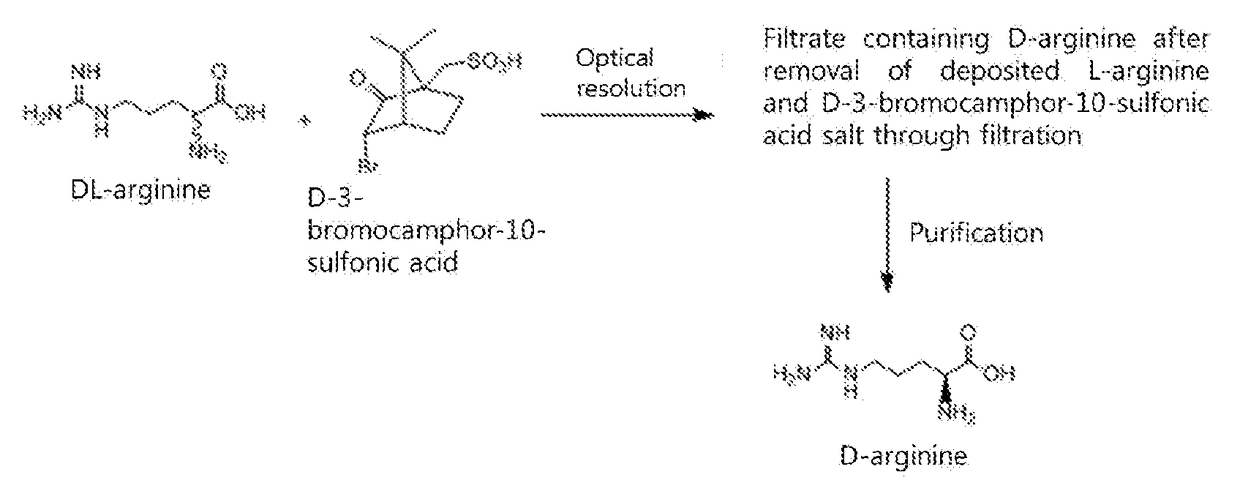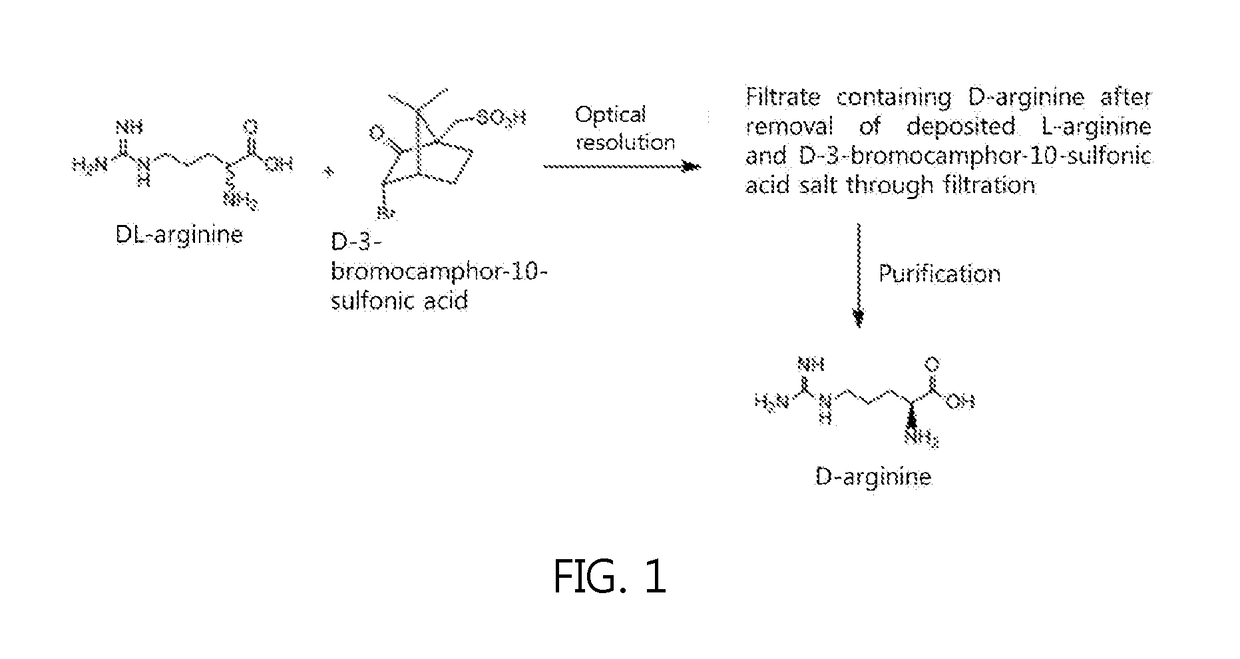Method for preparing d-arginine
a technology of d-arginine and dl-arginine, which is applied in the field of preparing darginine, can solve the problems of undesirable effects, difficult to accurately confirm the optical purity of the obtained d-arginine, and the l-arginine contained in dl-arginine is not recovered but decomposes, etc., and achieves excellent optical resolving effect, simple preparation process, and increased optical purity.
- Summary
- Abstract
- Description
- Claims
- Application Information
AI Technical Summary
Benefits of technology
Problems solved by technology
Method used
Image
Examples
example 1
[0026]DL-arginine (42.5 g, 244 mmol) and D-3-bromocamphor-10-sulfonic acid monohydrate (60.3 g, 183 mmol, 0.75 equivalents (eq.)) were added to 1300 mL of methanol, heated to 60° C. so as to be dissolved, and then slowly cooled.
[0027]The resulting solution was stirred at room temperature for 2 hr, and the deposited L-arginine and D-3-bromocamphor-10-sulfonic acid salt were filtered off.
[0028]Thereafter, the remaining filtrate was concentrated, dissolved in 500 mL of distilled water, passed through a column filled with an ion exchange resin (IRC-86, NH4 type) to adsorb D-arginine, and washed with distilled water. The adsorbed D-arginine was desorbed using 5% ammonia water, and the desorbed aqueous solution was concentrated again, thereby obtaining D-arginine.
[0029]The optical purity of D-arginine thus obtained was analyzed using a chiral column (Sumichiral OA-5000 column), and the analysis conditions were as follows.
[0030]Column: Sumichiral OA-5000 (5 μm, 4.6±250 mm)
[0031]Mobile phas...
example 2 to 4
[0036]D-arginine was prepared in the same manner as in Example 1, with the exception that the D-3-bromocamphor-10-sulfonic acid monohydrate was used in amounts of 0.6, 0.7 and 1 equivalents (eq.) in Examples 2, 3 and 4, respectively, and the optical purity of the prepared D-arginine was analyzed using a chiral column, as in Example 1.
[0037]The results of the optical purity of D-arginine prepared in Examples 1 to 4 are shown in Table 1 below.
TABLE 1Amount (eq.) of D-3-bromocamphor-10-sulfonic acidD-arginine-to-L-arginine ratio inmonohydratefiltrateEx. 10.75 eq. 95:5Ex. 20.6 eq. 85:15Ex. 30.7 eq.92:8Ex. 41.0 eq.97:3
[0038]As is apparent from the results of Table 1, when the amount (eq.) of the D-3-bromocamphor-10-sulfonic acid monohydrate used as the optical resolving agent in the present invention was increased, the optical resolving effect of DL-arginine was raised, thus increasing the optical purity of D-arginine.
[0039]Also, when D-arginine obtained in Example 1 was additionally rec...
examples 5 to 7
[0040]D-arginine was prepared in the same manner as in Example 1, with the exception that a D-3-bromocamphor-10-sulfonic acid ammonium salt was used as the optical resolving agent, in lieu of the D-3-bromocamphor-10-sulfonic acid monohydrate, and was used in amounts of 0.9, 1 and 1.1 equivalents (eq.) in Examples 5, 6 and 7, respectively, and the optical purity of the prepared D-arginine was analyzed using a chiral column, as in Example 1. The results are shown in Table 2 below.
TABLE 2Amount (eq.) of D-3-bromocamphor-10-sulfonic acidD-arginine-to-L-arginine ratio inammonium saltfiltrateEx. 50.9 eq.95:5Ex. 61.0 eq.96:4Ex. 71.1 eq.97:3
[0041]Similar to the results of Examples 1 to 4, when the amount (eq.) of the D-3-bromocamphor-10-sulfonic acid ammonium salt used as the optical resolving agent was increased, the light-splitting effect of DL-arginine was raised, thus increasing the optical purity of D-arginine.
[0042]Consequently, the present invention, which pertains to the preparation...
PUM
| Property | Measurement | Unit |
|---|---|---|
| pH | aaaaa | aaaaa |
| chiral chromatography | aaaaa | aaaaa |
| optical purity | aaaaa | aaaaa |
Abstract
Description
Claims
Application Information
 Login to View More
Login to View More - R&D
- Intellectual Property
- Life Sciences
- Materials
- Tech Scout
- Unparalleled Data Quality
- Higher Quality Content
- 60% Fewer Hallucinations
Browse by: Latest US Patents, China's latest patents, Technical Efficacy Thesaurus, Application Domain, Technology Topic, Popular Technical Reports.
© 2025 PatSnap. All rights reserved.Legal|Privacy policy|Modern Slavery Act Transparency Statement|Sitemap|About US| Contact US: help@patsnap.com


